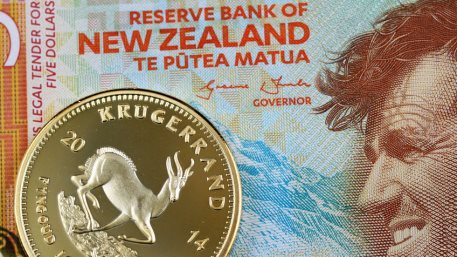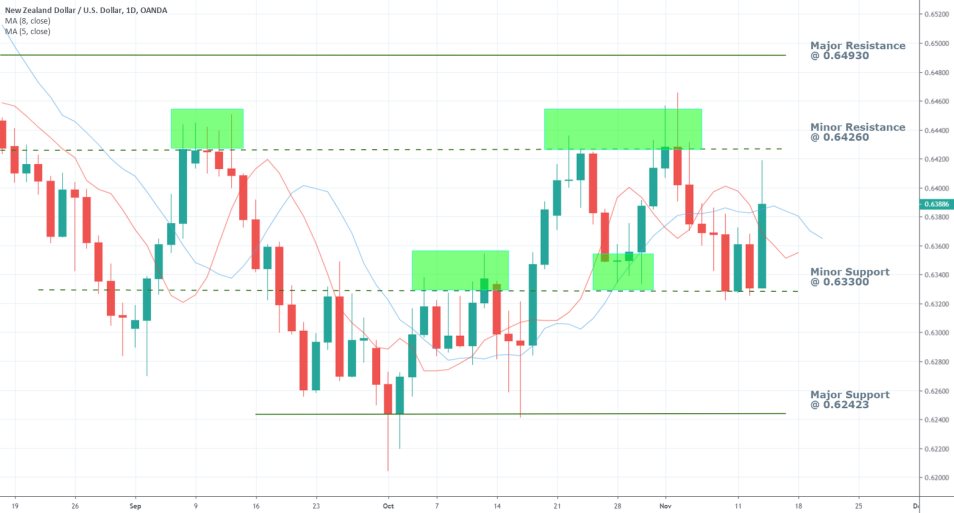
The Monetary Policy Committee (MPC) of the Reserve Bank of New Zealand has reached a consensus on early Wednesday in voting to keep the OCR rate unchanged in November.
The Committee has reviewed the most recent economic developments both domestically and also internationally.
Even though it was noted that global risks to growth remain to the downside and trade uncertainty remains high, the current economic circumstances do not warrant further reductions in the OCR at the current rate.
This decision prompted a surge in all NZD currency pairs, as the initial market forecasts projected a likely reduction of the interest rate by 0.25 basis points.
We cautioned you against these estimations in our Weekly Expectations update from Monday, in which we argued that not all economic indicators signal a reduction and also that:
“A more favourable business outlook is likely to prompt heightened business activity, which could prove sufficient for the MPC of the RBNZ to postpone any reductions until 2020.”
In its monetary policy statement, the MPC argued along similar lines, stating that growth is expected to pick up in 2020 prompted by heightened business activity:
“Domestic economic activity is expected to increase during 2020 supported by low interest rates, higher wage growth, and increased government spending and investment. The low level of the OCR has flowed through to lower lending rates more generally, which support spending and investment. Rising capacity pressures are projected to promote a pick-up in business investment.”
The decision to abstain from reducing the interest rate presently was also backed up by the strong performance of the domestic labour market and robust growth in wages – a trend that is observable worldwide.
Inflation remains subdued but within the Monetary Policy Committee’s long-term projections.
“Employment remains around its maximum sustainable level while inflation remains below the 2 percent target mid-point but within our target range.”
Overall, MPC’s decision to keep the interest rate unchanged means that the New Zealand Dollar will not suffer from speculative selling pressure in the immediate future.
The NZDUSD has been trading around the support level at 0.63300 for the past three days, and the pair bounced off from the level today, following the announcement of the monetary policy decision.
The price of the pair almost reached the next important level at 0.64260 before correcting some of those initial gains by tumbling to around 0.63900.
This behaviour of the NZDUSD matches our projections from Monday, as we argued that:
“Wednesday’s decision is likely to prompt heightened trading activity, which could subsequently cause the price to break out of the range’s boundaries.”
Currently, the price of the currency pair is attempting to break out above the 8-day Simple Moving Average on the daily chart.

Trendsharks Premium
Gold is undergoing a correction, as investors take profits to offset losses from falling stock prices, impacting their margins. However, we anticipate a renewed wave of [...]
The Swiss stock market index is mirroring its global counterparts, such as Germany 40 and US100, experiencing a sharp decline following the announcement of new [...]
We’re analyzing the weekly chart to grasp the broader market trend. Over the past three years, the US30 index has surged by 17,000 points, often resembling a nearly straight [...]
Over the past week, the DAX has experienced a sharp decline, plunging by an astonishing 3,400 points. This downward movement is not isolated, as its international counterparts, such as the UK100 and US100, are also facing significant [...]
EURUSD recently formed a double top at 1.0930, signaling a potential trend reversal, and has since begun a correction. After a 600-pip rally since early March, a pullback at this stage is both expected and healthy. Given these conditions, we are placing a [...]
Since early March, EURJPY has surged nearly 1,000 pips, providing us with several excellent trading opportunities. However, as the rally matures, many early buyers are beginning to take profits, leading to a noticeable slowdown in the uptrend. On Friday, the pair formed a [...]
The AUDJPY currency pair continues to be dominated by bullish momentum, as multiple golden cross patterns reaffirm the strength of the ongoing uptrend. Despite this, we are witnessing a much-needed [...]
The EURAUD currency pair appears to be undergoing a trend reversal, signaling a potential shift in market direction. A notable technical development is the formation of a Death Cross on the chart, a widely recognized bearish indicator that typically suggests a [...]
After securing an impressive 200-pip profit last week, the EURJPY currency pair is now undergoing a southward correction, retracing some of its recent gains. Despite this temporary pullback, the Golden Cross remains intact, reinforcing our view that the overall trend continues to be [...]
The appearance of a Golden Cross in Silver strengthens our analysis that the metal is currently in a strong uptrend, indicating further bullish momentum in the market. This technical pattern, where the short-term moving average crosses above the [...]
This trade presents a considerable level of risk and can be classified as an opportunistic move based on recent price action. The GBPUSD currency pair has experienced a substantial bullish rally, surging by nearly 500 pips in a strong upward movement. However, after this extended period of appreciation, the pair is showing signs of a potential [...]
The anticipated Death Cross on the SMI20 appears to be failing as price finds strong support at the 23% Fibonacci retracement level. After testing this area, the index has shown bullish strength, printing several large green candles, signaling an increase in [...]
A Golden Cross has just appeared on the USDJPY chart, signaling a potential bullish move. This technical pattern occurs when the 20 period moving average crosses above the 60 period moving average, a widely recognized indication of increasing [...]
After 2 months of a down trend, we finally see some indications of price recovery for Oil. The golden cross, a historic buy signal, supports this [...]
For the past month, the German DAX40 has experienced a remarkable 10% surge, reflecting strong bullish momentum. Despite ongoing market volatility and frequent pullbacks, every dip continues to attract fresh buyers, reinforcing the [...]
Oil continues its downward trajectory, despite occasional pullbacks. The overall trend remains bearish, reinforced by multiple Death Cross patterns, a classic sell signal indicating further weakness. Adding to this bearish outlook, the critical [...]
Over the past few days, gold has experienced a sharp decline of more than $100. This downturn can be attributed in part to traders securing profits to manage their margins, which are under strain due to the significant drop in major indices. Currently, gold has fallen below the [...]
The NASDAQ 100 index is showing strong bullish momentum, as evidenced by the formation of a Golden Cross on the chart. This classic buy signal occurs when the short moving average crosses above the long term moving average, suggesting that upward momentum is [...]
The EURAUD currency pair has encountered a significant resistance level, failing to break above the critical 61% Fibonacci retracement level. This suggests that bullish momentum is weakening, reinforcing the case for a potential downward move. Given this technical setup, we favor entering a [...]
The UK100 is experiencing a remarkable rally! Over the past few weeks, the British stock market index has surged nearly 800 points. Each minor dip has attracted more buyers, fueling the bullish momentum. However, since last week, we’ve observed a slight [...]




















